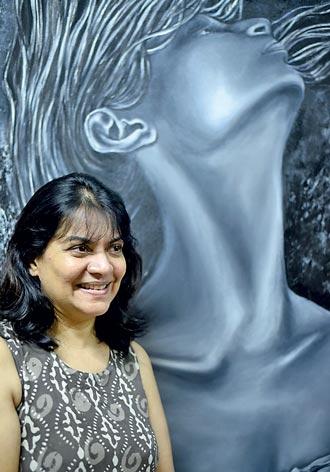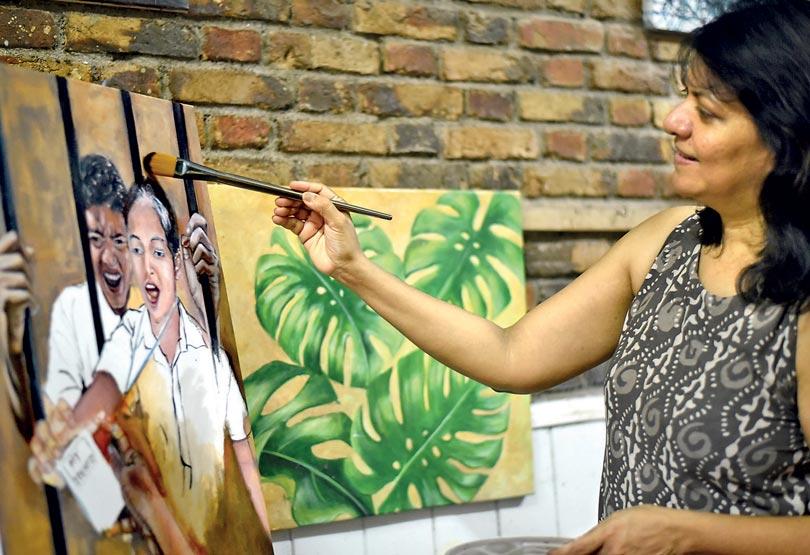
I explore with a lot of media. I use newspapers, I use bubble wrap, I use tissues, toilet paper rolls, you name it. If I can paste it on a canvas, I’ll experiment with it. You must go all out and try these crazy things! Only then would you know what works and what doesn’t.

Aruni 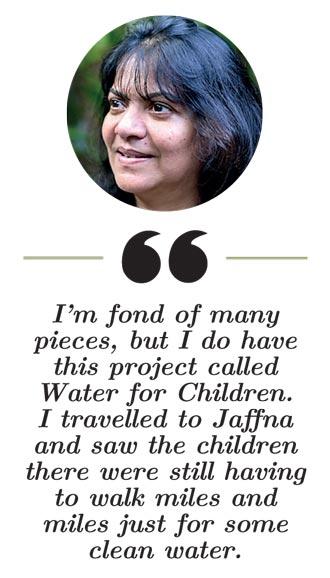 Wijegunawardene, an artist and art teacher, isn't just passionate about inspiring students to unleash their creativity and hone their artistic skills. She recognises the transformative power of art in unexpected places. In this piece, we'll delve into Aruni's artistic journey and explore how her approach bridges the gap between the arts and various industries.
Wijegunawardene, an artist and art teacher, isn't just passionate about inspiring students to unleash their creativity and hone their artistic skills. She recognises the transformative power of art in unexpected places. In this piece, we'll delve into Aruni's artistic journey and explore how her approach bridges the gap between the arts and various industries.
Q: Take us back to when this all began, your passion for art and painting.
My passion for it was always there. As a child, I’d pretend to be a professional artist and dabble with a paintbrush, envisioning being a success. Morning, noon and night, even in my dreams, I would just paint. I had wonderful parents who encouraged me constantly and I had uncles and aunts who brought paint and paintbrushes when they would visit from overseas, so I was able to explore without any cost. Eventually, when I got married, my husband encouraged me too. It was a continuous luxury I received, throughout.
Q: Art often sparks conversation. How can we create a more open and inviting atmosphere for discussing art, where everyone feels welcome to share their thoughts and interpretations?
It’s nice to be able to freely form an opinion about a piece of art, without others taking it as a personal assault against them. Art should be discussed, everyone has an opinion and preference. Some purely to display their work to enhance the appearance of a space and others appreciating the deeper meaning and skill. Art, good or bad, is always discussed. It’s great if one can engage with a piece and find a personal connection to it.
Q: Do you feel art permeates different industries beyond the traditional art world?? How can we better leverage the unique perspectives of artists to foster innovation across different industries?
Yes I do. Art and manufacturing have been intertwined throughout time with artists and craftsmen collaborating with manufacturers to create beautiful and functional objects. Artists also have the ability to visualise a thought and express this creatively, when others cannot. Many are the voice for the voiceless on social media, creating concepts to promote others work. So the relationship between art and manufacturing is very significant, as both domains working together has been increasingly fruitful to both.
Q:We see you doing mural work. What does it mean to you?
I do murals only on request. I enjoy it a lot. It’s a source of relaxation for me since I don’t think too much about it. I do plan though and I try to understand the surroundings and create something that blends cohesively with the environment. But other than that, it’s a lot of fun.
Q: What/who inspires your art?
Every day experiences inspire me, unique things, even my students.. and happy people. I believe happiness is what we must generate with everybody. With social media and the news nowadays, there is a constant flow of negativity. We only focus on misfortune and chaos. If we spread laughter and joy, we generate positive vibes within ourselves and the people around us will inevitably attract this positive energy.
Q: Can you discuss any specific tools or mediums that are critical to your artistic practice?
I explore a lot of media. I use newspapers, bubble wrap, textured paper, tissues, you name it. If I can paste it on a canvas, I’ll experiment with it. You must go all out and experiment using any media. Only then would you know what works and what doesn’t.
Q: What piece of work are you proud of and what’s the story behind it?
I’m fond of many pieces, but I do have this project called Water for Children. I travelled to Jaffna and saw the children there still having to walk miles and miles just for clean water. I was satisfied with that collection because of that particularly impactful message.
I layered the base of these pieces with Tamil newspapers, and after painting a nude colour over it, I printed textured board prints and splashed black and white paint to create my background. I then painted my subject over, but I left certain areas unfinished, wanting to convey that their lives may never be complete anytime soon due to the hardships they had to endure.
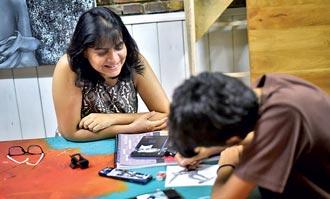
That series conveyed being unable to grow and evolve into their ambitions as they’re not provided with the proper care that we were given here in Colombo. It was upsetting to witness it at this stage, post-war. Jaffna is beautiful, and so are the people. Their presence and generosity were fantastic. We were taken by an old gent who used to work for the Red Cross on that trip and he related stories of them not being able to own their properties, informing us that they were still restricted despite all these years. A lot of that went into my head and I was quite disturbed, so when I came back home, I painted what I saw and felt. Most of us are unaware of what’s happening in the North and our minds have been manipulated to think about division. We are not truly divided, it is only just a mere delusion. We have to be educated enough to be free, all of us. Therefore, I’m content that this collection stands as a strong visual expression of their situation to inform the people of the truth.
Q: What’s your favourite part of being an art educator?
The energy I get when I see them, I just love it. As well as the engagement I have with them and their art itself. I love watching them develop and improve, even when they whine when given challenging pieces. When I realise someone is capable of more, I encourage them to attempt more skilled work. They are astounded by their own ability. If I feel they can’t, I allow them to discover other ways to execute their pieces. When students tell me they don’t care about the mark they receive, and say “Look at what I can do”, that’s when I know they have matured in the process. Some kids want me to take them all the way, so I show them different techniques and encourage them to be open-minded about other mediums and ideas, but I have to recognise who wants to move forward and who doesn’t. We have to understand that they come from different backgrounds and are carrying baggage from their own lives, so we have to be very tactful and make sure we give them our utmost support. Show them that we are there for them and that our channels are open for them if they want to talk. If they don’t want to, just leave them be, but always allow them to express themselves, especially visually.
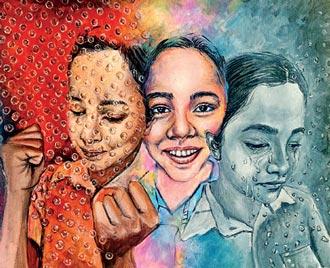
Q: What is your ultimate dream?
At some point when I am no more, I want people to think of me or my work as having influenced others positively. I want people to recognise my work and say “That’s Aruni’s.”
I am influenced by the likes of Caravaggio and Rembrandt, who all made a huge impact with their work. They didn’t just draw people mindlessly, they wanted to convey a message. At the end of the day, are we taking all this wherever we’re going after we’re gone? If we can bring about a positive change, we must do that. You must strive to be that positive change in someone else’s life. That is your purpose, and you can do it, however, not just through art. If you can make someone else happy or make them feel valued, even just for a fraction of a second, do that.
Q: What advice would you give to aspiring artists?
Be true to yourself and persevere. Keep at it until you get where you want and don’t overthink it. One thing I tell my students is, you need to learn to walk before you run. So take it easy and learn.step by step. You might or might not get it at the beginning. Don’t get frustrated, give yourself a break. Be satisfied with what you have done today. Tomorrow is another day, and you can try again. Always encourage yourself, pat yourself on the back and say, you did good.
Pix by Kushan Pathiraja


 Wijegunawardene, an artist and art teacher, isn't just passionate about inspiring students to unleash their creativity and hone their artistic skills. She recognises the transformative power of art in unexpected places. In this piece, we'll delve into Aruni's artistic journey and explore how her approach bridges the gap between the arts and various industries.
Wijegunawardene, an artist and art teacher, isn't just passionate about inspiring students to unleash their creativity and hone their artistic skills. She recognises the transformative power of art in unexpected places. In this piece, we'll delve into Aruni's artistic journey and explore how her approach bridges the gap between the arts and various industries.